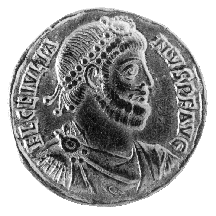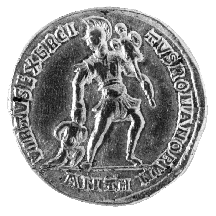



(129) Julian II - AV solidus, A.D. 362, 3.97 g. (inv. 91.249).
Obverse: Diademed, draped, and cuirassed bust of Julian II r.; FL(AVIVS)
CL(AVDIVS) IVLIANVS P(IVS) F(ELIX) AVG(VSTVS): Flavius Claudius Julianus,
pious, fortunate Augustus.
Reverse: Soldier, helmeted, standing r., head to l., holding trophy in l.,
dragging captive with r.; VIRTVS EXERCITVS ROMANORVM: the valour of the
Roman army; in exergue, ANTH: Antioch.
Provenance: Abner Kreisberg, 1960.
Bibliography: J.P.C. Kent, The Roman Imperial Coinage VIII: The Family
of Constantine A.D. 337-364 (London 1981) Antioch 203.
Flavius Claudius Julianus, known to history as Julian the Apostate, was
a nephew of Constantine, born in the imperial capital of Constantinople
in A.D. 332. He and his brother, Gallus, were the only male members of the
side of Constantine's family descended from his father's first wife, Theodora,
rather than from Constantine's mother, Helena, to survive the massacre of
A.D. 337, an apparent attempt to wipe out that side of the family. He spent
his early years studying philosophy in Asia Minor, where he first became
interested in the worship of the old pagan gods. He was made Caesar by the
emperor Constantius II in A.D. 355 and posted to Gaul, where he was successful
in dealing with the Germans. His popularity with his troops resulted in
his proclamation as emperor in A.D. 360. He was spared a war with the emperor
by Constantius' death in A.D. 361. He openly renounced Christianity, which
earned him the name Apostate, and tried unsuccessfully to restore paganism.
He was killed in battle in A.D. 363.
The portraits of Julian are striking in that he rejected the beardless portrait
tradition that had begun with Constantine, probably because of its association
with Christianity, and wore instead the beard of earlier pagan emperors.
The reverse also reverts to earlier types and even to the more naturalistic,
Classical style that was used to portray them.
J.D.G.



All contents copyright (c) 1996.
Lawrence University
All rights reserved.